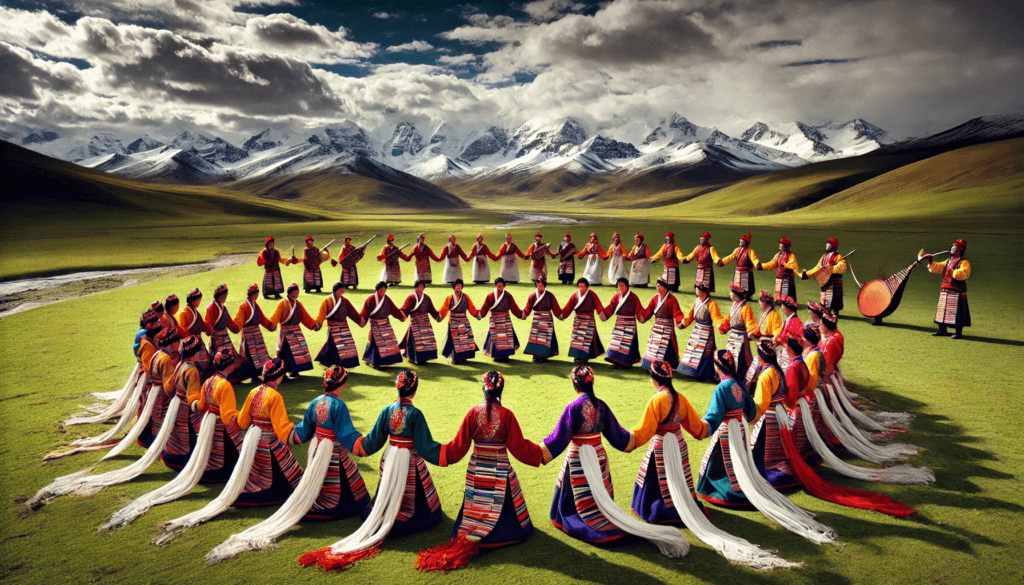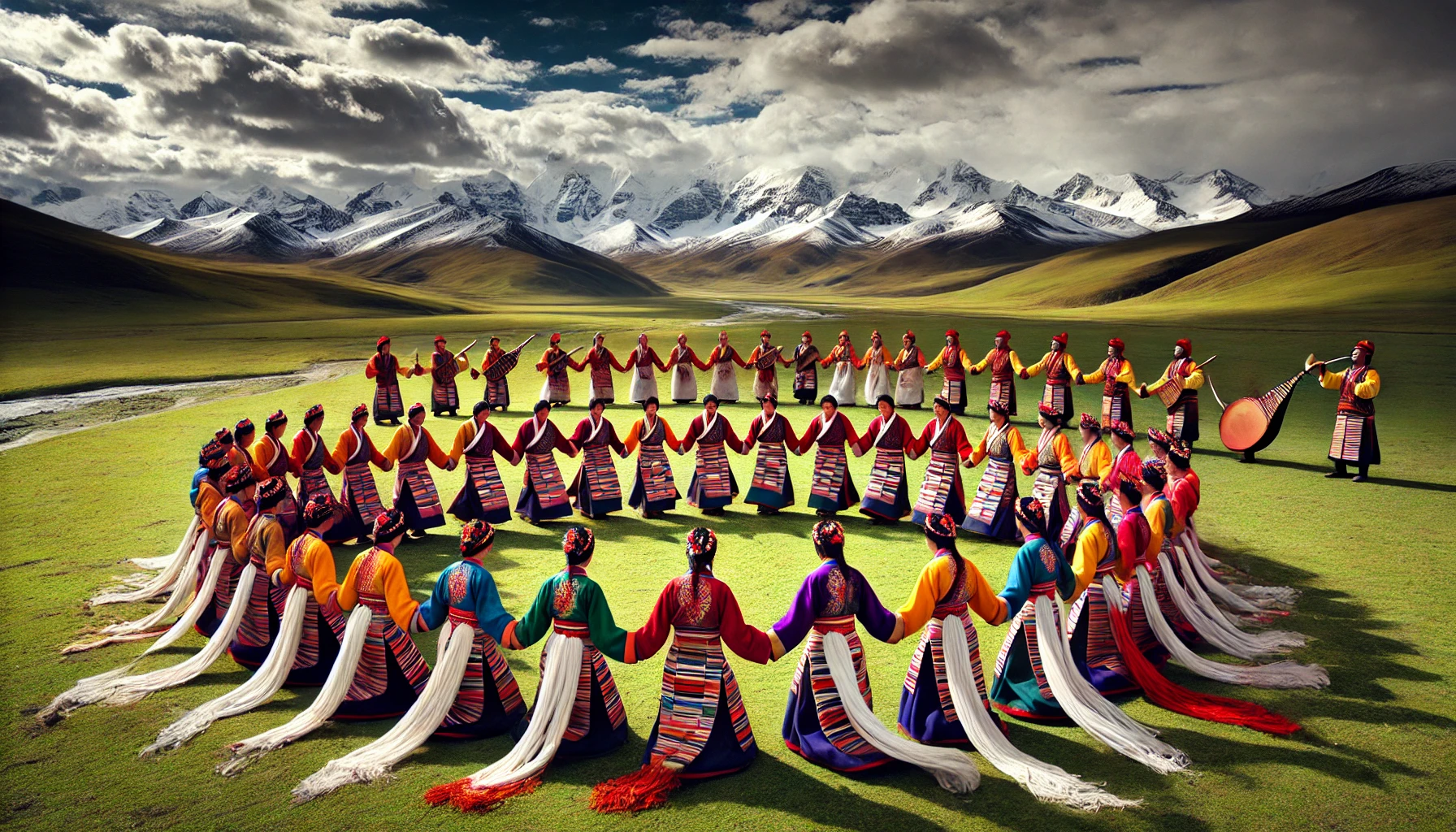
The Tibetan Plateau
A folk song from Tibet
A well-known folk song from Tibet is “The Tibetan Plateau” (Tibetan: བོད་རིགས་གྲོང་ཁྱེར་བཞི). This song is a beautiful reflection of the Tibetan people’s deep connection with their land, culture, and spirituality.
An overview of the song and its cultural significance
Lyrics and Theme
The song describes the vast and majestic Tibetan Plateau, highlighting its natural beauty and spiritual significance. It often includes imagery of snow-capped mountains, vast grasslands, and the serene lifestyle of Tibetan nomads. The lyrics typically convey a sense of pride and love for the homeland, emphasizing the peaceful and harmonious coexistence with nature.
Cultural Context
- Spirituality: Tibet is known for its rich spiritual traditions, especially Tibetan Buddhism. Folk songs like “The Tibetan Plateau” often incorporate themes of spirituality, reflecting the deep connection between the Tibetan people and their religious beliefs.
- Nomadic Life: Many Tibetans have traditionally led a nomadic lifestyle, herding yaks and sheep across the plateau. This lifestyle is celebrated in the song, depicting the simplicity and resilience of the nomadic way of life.
- Natural Beauty: The Tibetan Plateau is one of the highest and largest plateaus in the world, often called “the Roof of the World.” The song’s vivid descriptions of the landscape capture the awe-inspiring beauty of this region.
Musical Elements
- Instruments: Traditional Tibetan instruments like the dranyen (Tibetan lute), lingbu (bamboo flute), and dungchen (long horn) are commonly used in folk music.
- Melody and Rhythm: Tibetan folk songs often feature a melodic structure that is both soothing and uplifting, with rhythms that mimic the natural flow of the landscape.
Performance
- Dance and Rituals: The song is sometimes performed with traditional Tibetan dances, which are graceful and incorporate symbolic movements. These performances can be part of larger cultural festivals or religious ceremonies.
- Festivals: “The Tibetan Plateau” might be sung during important Tibetan festivals such as Losar (Tibetan New Year) or during gatherings that celebrate cultural heritage.
Example Lyrics (in Tibetan with Translation)
(Note: The lyrics are provided as an example and may vary as folk songs often have multiple versions)
Tibetan:
བོད་རིགས་གྲོང་ཁྱེར་བཞི། ལྷག་པ་གང་གཏན་ལ་སྒྲོལ། དེ་བཞིན་འགྱུར་མེད་པའི་སྐལ་བ། དེར་དོན་མེད་འཚོ་བར་བཞེས།
Translation:
The Tibetan Plateau,
our homeland Ever pure and free,
With unchanging destiny,
We live in peace and harmony.
Significance
“The Tibetan Plateau” serves as a cultural emblem, encapsulating the essence of Tibetan identity and the profound bond between the people and their land. It is a beautiful representation of how music can preserve and celebrate the heritage and values of a community.
“Guoxie” or “Tibetan Circle Dance”
There is a traditional dance often associated with Tibetan folk songs like “The Tibetan Plateau.” This dance is known as the “Guoxie” or “Tibetan Circle Dance”.
Here are some details about the dance:
Guoxie (Tibetan Circle Dance)
Description
- Formation: Dancers form a circle, holding hands or linking arms, and move together in a coordinated fashion. The circular formation symbolizes unity and harmony within the community.
- Movements: The dance movements are generally smooth and flowing, reflecting the natural landscapes and the tranquil lifestyle of the Tibetan people. Steps often include side-to-side motions, gentle hops, and coordinated footwork that align with the rhythm of the music.
Cultural Significance
- Community Bonding: The circle dance is a communal activity that brings people together, strengthening social bonds and fostering a sense of collective identity.
- Spiritual Expression: Dance in Tibetan culture is not just entertainment but also a form of spiritual expression. The movements can be symbolic, representing various aspects of life, nature, and spirituality.
Performance Context
- Festivals and Celebrations: Guoxie is commonly performed during festivals such as Losar (Tibetan New Year), harvest festivals, and religious celebrations. It can also be part of weddings and other important social events.
- Costumes: Dancers often wear traditional Tibetan attire, which includes colorful robes (chubas), wide belts, and ornate headpieces. These costumes add to the visual splendor of the performance and are an essential part of the cultural expression.
Musical Accompaniment
- Instruments: The dance is accompanied by traditional Tibetan instruments like the dranyen (Tibetan lute), dungchen (long horn), and percussion instruments such as drums and cymbals.
- Songs: The songs sung during the dance are usually folk songs that reflect themes of nature, love, spirituality, and daily life.
Example of a Guoxie Performance
Steps:
- Starting Position: Dancers form a circle, holding hands.
- Basic Steps: Gentle side-to-side steps, moving in a clockwise direction.
- Variations: Occasional hops, twirls, or more intricate footwork depending on the song’s tempo and the dancers’ skill level.
- Unity and Harmony: Throughout the dance, the emphasis is on maintaining the circle and moving as one cohesive group.
Significance in “The Tibetan Plateau”
- Embodying the Song’s Themes: When performed with “The Tibetan Plateau,” the dance movements embody the song’s themes of love for the homeland, unity with nature, and spiritual serenity.
- Visual and Emotional Impact: The combination of music, lyrics, and dance creates a powerful emotional and visual impact, celebrating the beauty and resilience of Tibetan culture.
Conclusion
The Guoxie dance is a beautiful and integral part of Tibetan folk music traditions, adding a dynamick and interactive element to songs like “The Tibetan Plateau.” It highlights the community’s cultural richness and the harmonious relationship between the people, their land, and their spiritual beliefs.

A visual representation of the traditional Tibetan circle dance (Guoxie) being performed, capturing the unity and harmony of the community.
Visual and Cultural Significance
- Costumes: The colorful traditional attire (chubas) and ornate headpieces add to the visual splendor and cultural authenticity.
- Setting: The dance is often performed on open grassy plateaus, symbolizing the close relationship with nature and the majestic Tibetan landscape.
This combination of music, dance, and traditional costumes beautifully showcases the rich cultural heritage of Tibet.
Detailed Dance Instructions for Guoxie
Basic Step-by-Step Guide
- Starting Position:
- Form a circle with all participants holding hands or linking arms.
- Stand with feet together and relax your body.
- Side-to-Side Steps:
- Step to the Right:
- Step to the right with your right foot.
- Bring your left foot to meet your right foot.
- Step to the Left:
- Step to the left with your left foot.
- Bring your right foot to meet your left foot.
- Step to the Right:
- Incorporating Gentle Hops:
- As you step to the right, add a gentle hop on the right foot before bringing the left foot over.
- Repeat on the left side, hopping on the left foot before bringing the right foot over.
- Twirl and Spin Variations:
- Occasionally, at key points in the music, perform a gentle twirl.
- Turn in place with a smooth, controlled spin, then rejoin the circle steps.
- Maintaining the Circle:
- Ensure the circle remains cohesive, with no gaps between dancers.
- Synchronize your steps with the group, paying attention to the rhythm and flow.
Coordinating with the Music
- Rhythm and Tempo: Move in time with the beat, adjusting your speed to match the tempo of the music.
- Listening to Cues: Watch and listen for cues from the leader or musicians for any changes in pace or direction.
Musical Accompaniment
Traditional Tibetan Instruments
- Dranyen (Tibetan Lute):
- A string instrument that provides melodic lines and harmonic support.
- Often features a deep, resonant sound with a distinct Tibetan character.
- Dungchen (Long Horn):
- A large, ceremonial horn used in Tibetan music, known for its deep, powerful tones.
- Typically used to signal important moments in the dance or music.
- Lingbu (Bamboo Flute):
- A traditional flute with a bright, clear sound.
- Adds melodic flourishes and complements the vocal lines.
- Ngachin (Drum):
- A hand-held drum used to maintain rhythm and add percussive texture.
- Provides a steady beat that dancers follow.
Structure of the Music
- Introductory Section: The music often begins with an instrumental introduction, setting the tone and tempo.
- Verse and Chorus: Alternating vocal and instrumental sections, where dancers can vary their steps.
- Crescendo: The music builds to a peak, often prompting more energetic dance moves like hops or spins.
- Resolution: The piece concludes with a slower, calming section, allowing dancers to gracefully end the performance.
Cultural Context and Significance
- Spiritual Connection: The dance and music are deeply intertwined with Tibetan spiritual practices, reflecting harmony with nature and the cosmos.
- Community Bonding: Performing the dance fosters a sense of unity and collective identity among participants.
- Celebratory Nature: Often part of festivals and special occasions, celebrating the richness of Tibetan culture and heritage.
A musical notation
I’ll describe the notation for a simple melody that could be played on the dranyen (Tibetan lute). Here’s a basic example:
Simple Melody Notation for Dranyen
Key: G Major
Time Signature: 4/4
Tempo: 80 BPM
Notation
| G4 | A4 | B4 | C5 |
| D5 | C5 | B4 | A4 |
| G4 | A4 | B4 | C5 |
| D5 | C5 | B4 | A4 |
Detailed Description
- G4: Quarter note G in the 4th octave
- A4: Quarter note A in the 4th octave
- B4: Quarter note B in the 4th octave
- C5: Quarter note C in the 5th octave
- D5: Quarter note D in the 5th octave
Each note is played for one beat in a 4/4 time signature, with a steady tempo of 80 beats per minute.
Tablature for Dranyen (if applicable)
If you have a dranyen (Tibetan lute) or a similar string instrument, you can play the notes on the following frets and strings:
- G4: 3rd fret, 1st string
- A4: 5th fret, 1st string
- B4: 7th fret, 1st string
- C5: 8th fret, 1st string
- D5: 10th fret, 1st string
Shop tips
Multilingual Folk Song Explorer GPT
Engaging and comprehensive folk song guide with interactive and multimedia features.
Multilingual Folk Song Explorer
Make your own folk website online!
Turn your passion into profit today and start your own online journey. Learn how to create and grow your website withna fabulous community and join for free!





